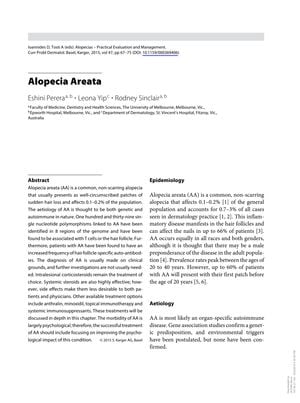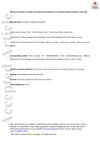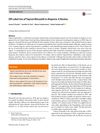Alopecia Areata
January 2015
in “Current problems in dermatology”

TLDR Alopecia Areata is an autoimmune hair loss condition that needs more research for better treatments.
The document from 2015 provides an overview of Alopecia Areata (AA), a common autoimmune form of hair loss with a genetic predisposition, affecting 0.1-0.2% of the population, mainly between ages 20 to 40. It describes AA as presenting with well-circumscribed patches of hair loss, primarily on the scalp, and notes that diagnosis is usually clinical. The document outlines various treatments, including intralesional corticosteroids as the first-line treatment, systemic steroids, anthralin, minoxidil, topical immunotherapy, and systemic immunosuppressants, while also highlighting the psychological impact of AA and the importance of psychological support. It mentions that spontaneous remission can occur in up to 50% of patients within a year, but also recognizes that long-standing, extensive AA has a poorer prognosis, with several factors indicating a worse outcome. The document concludes with a call for further research into the genetics and autoimmunity of AA to improve treatment options.
View this study on karger.com →
Related
research Potential Herbal Medicine for Alopecia Areata Treatment: A Systematic Review

research The Efficacy of Azelaic Acid 20% Cream in the Treatment of Scalp Alopecia Areata
Azelaic acid 20% cream works well for treating scalp alopecia areata and can be an alternative to clobetasol ointment.

research Efficacy of systemic minoxidil and tofacitinib combination in treatment‐resistant alopecia universalis
Using minoxidil and tofacitinib together can effectively treat severe hair loss.

research Off-Label Use of Topical Minoxidil in Alopecia: A Review
Minoxidil helps treat eyebrow thinning, monilethrix, early hair loss, and shortens chemo-related hair loss.
research Alopecia Areata: Evidence-Based Treatments

research Treatments for Androgenetic Alopecia and Alopecia Areata
Minoxidil and finasteride treat hair loss; more research needed for other options.

research Topical Minoxidil
Minoxidil promotes hair regrowth, but more research needed for effectiveness and response factors.

research Topical Minoxidil in the Treatment of Alopecia Areata
Minoxidil helps hair regrowth in alopecia patients, with 16 having good results and no side effects.